User manual
1
R226-Z
Quick Start Guide
ZTE CORPORATION
NO. 55, Hi-tech Road South, Shenzhen, P.R.China
Postcode: 518057
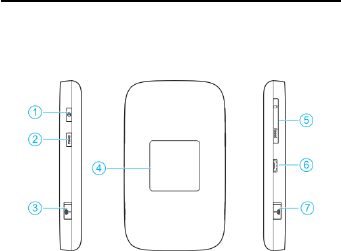
2
Getting to Know Your Device
Appearance
The following figure is for your reference only.
1. Power key
2. FUNC key
3. External antenna connector
4. LCD screen
5. micro-SIM card slot cover and reset hole
6. Charging/micro-USB jack
7. External antenna connector
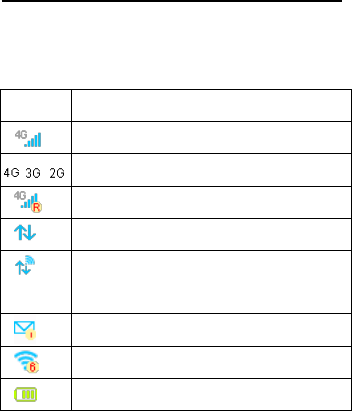
3
Getting to Know Your Device
Indicators
When the device is powered on, the following icons may be
displayed on the LCD screen. For a description of the icons,
refer to the following table.
Icon
Description
Network signal strength
/ /
Network type
The user is in roaming status.
Connected to the Internet.
Connected to the Internet in the Internet Wi-Fi
mode.
New message (s)
Wi-Fi status and the number of connected users
Battery level
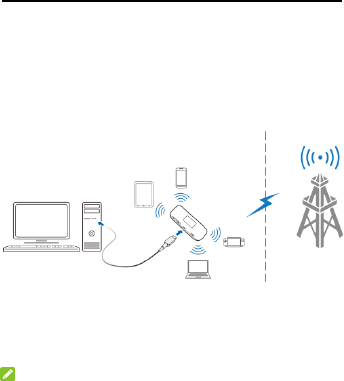
4
Getting to Know Your Device
Connection Scenarios
The device can access the Internet in two ways and it allows
multiple clients to surf on the Internet at the same time. The
following figures are for your reference only.
4G Mode: A micro-SIM card can be used to access the
Internet.
Internet Wi-Fi Mode: Your device can be connected to a
WLAN device (such as a hotspot device or wireless router)
through Wi-Fi to access the Internet. The WLAN device must
be already connected to the Internet.
NOTE:
Your device and the WLAN device must be in different subnets.
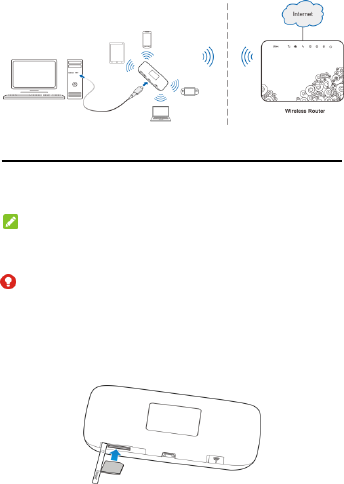
5
Installing the micro-SIM Card
1. Open the micro-SIM card slot cover, and install a micro-SIM
card to the micro-SIM card slot.
NOTE:
Do not remove the cover rudely, because it is connected with the
device.
WARNING!
To avoid damage to the device, do not use any other kind of SIM
cards, or any non-standard micro-SIM card cut from a SIM card.
You can get a standard micro-SIM card from your service
provider.

6
2. Close the micro-SIM card slot cover.
Connecting to Your Device
Using Wi-Fi
1. Power on your device.
2. Ensure that your computer or other client devices have
enabled Wi-Fi, and search for available wireless networks.
NOTE:
Refer to your Wi-Fi-enabled client device manual for further
details on how to search for wireless networks. If you use a
computer, you need to set your computer to obtain an IP
address automatically.
3. Select the Wi-Fi name (SSID) of your device, and click
Connect.
4. Enter the Wi-Fi password if necessary, and click OK.
NOTE:
Refer to the chapter Getting to Know the Wi-Fi SSID and
Password to get the default Wi-Fi SSID and password.
Connecting to Your Device
5. Wait until the client device is connected to your device
successfully.
Using a USB Cable
1. Connect a computer to your device with a USB cable.

7
2. Power on your device. The operating system detects and
identifies new hardware, and automatically installs the
hardware.
NOTE:
If the system does not automatically launch installation, you can
Double-click the device installation icon in My Computer to
install the software.
3. Wait until the computer is connected to your device
successfully.
Getting to Know the Wi-Fi SSID and
Password
You can use the following methods to get the default Wi-Fi SSID
and password.
View the label on the device.
Press the FUNC Key to access the options menu.
Select Device Info and the Wi-Fi SSID and password
are displayed on the screen.

8
Logging in to the 4G Mobile
Hotspot Configuration Page
1. Ensure that the connection between your device and the
client device is correct.
2. Launch the Internet browser and enter http://192.168.0.1 or
http://ufi.ztedevice.com in the address bar.
3. Enter the password to log in to the 4G Mobile Hotspot
configuration page.
NOTE: The default password is admin.
Changing the Wi-Fi SSID or
Password
1. Log in to the 4G Mobile Hotspot configuration page.
2. Select Settings below Wi-Fi and then click Main SSID.
3. Change the Network Name (SSID) or the Password in the
Main SSID area.
4. Click Apply.
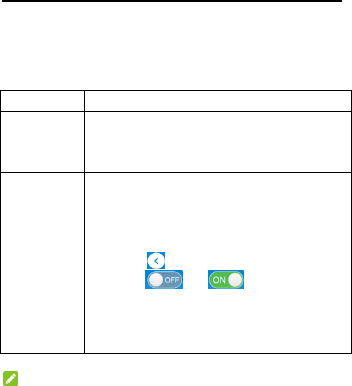
9
Accessing the Internet
4G Mode
After a client device is successfully connected to your device,
you can access the Internet in Automatic or Manual mode. The
default mode is Automatic.
Mode
Operation
Automatic
Your device is automatically connected to the
Internet, and you can surf on the Internet
through the client.
Manual
1. Log in to the 4G Mobile Hotspot
configuration page.
2. Select Settings > Connection Mode >
Manual, and then click Apply.
3. Click to back to the home page, and
click or .
You can also press the FUNC Key and
select Network Connection. Select Yes
or No.
NOTE:
To modify the parameters of your device, log in to the 4G Mobile
Hotspot configuration page.
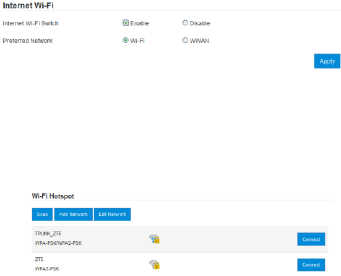
10
Internet Wi-Fi Mode
1. Log in to the 4G Mobile Hotspot configuration page.
2. Select Wi-Fi Settings > Internet Wi-Fi.
3. Set the Internet Wi-Fi Switch as Enable and then click
Apply.
4. Set the Preferred Network as Wi-Fi and then click Apply.
5. Connect to the Wi-Fi hotspot.
The following two methods are for your reference.
Select a Wi-Fi hotspot listed in the Wi-Fi Hotspot area and
click Connect. Enter a pass phrase in the Pass Phrase
text box and click OK.
Click Add Network, enter the Wi-Fi hotspot information in
the Add Wi-Fi Hotspot area, and click Apply. Click the
Wi-Fi hotspot you have added and then click Connect.
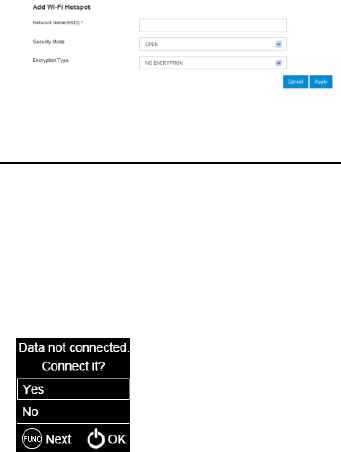
11
After the client device is connected to the Wi-Fi hotspot
successfully, you can access the Internet.
Using the FUNC Key
When the screen is off, press the FUNC key to turn on the
screen. When the screen is on, press the FUNC key to access
the following options menu. or Wi-Fi QR code, activate WPS
function, enable/disable global roaming or quick boot function
without logging in to the 4G Mobile Hotspot Configuration Page.
Data Connection
You can connect or disconnect with the Internet
1. Press the FUN key to show the options menu.
2. Press the Power key to select Data Connection.
3. Press the Power key to connect to the Internet or press the
FUN key and then press the Power key to disconnect from
the Internet.

12
Device Information
You can view the device information.
1. Press the FUN key to show the options menu.
2. Press the FUN key to scroll to Device Info and then press the
Power key.
3. Press the FUN key to see more information and then press
the Power key to go back to the home screen.
Wi-Fi QR code
You can view the device’s Wi-Fi QR code.
1. Press the FUN key to show the options menu.
2. Press the FUN key to scroll to Wi-Fi QR code and then press
the Power key.
3. You will see the Wi-Fi QR code and then press the Power key
to go back to the home screen.
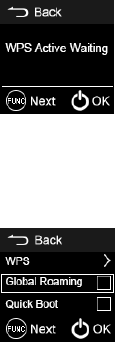
13
WPS
You can activate the WPS function.
1. Press the FUN key to show the options menu.
2. Press the FUN key to scroll to WPS and then press the
Power key.
3. Press the Power key to activate the WPS function.
Global Roaming
You can enable or disable global roaming.
1. Press the FUN key to show the options menu.
2. Press the FUN key to scroll to Global Roaming.
3. Press the Power key to enable or disable global roaming.

14
Quick Boot
You can enable or disable quick boot function without logging in
to the 4G Mobile Hotspot Configuration Page.
1. Press the FUN key to show the options menu.
2. Press the FUN key to scroll to Quick Boot.
3. Press the Power key to enable or disable quick boot.

15
Configuring Your PC
The following describes how to configure the Internet Protocol in
the Windows 7 operating system for your Wi-Fi connection.
1. Right-click Network and select Properties.
2. Select Change adapter settings.
3. Right-click Wireless Network Connection and select
Properties.
4. Select Internet Protocol Version 4 (TCP/IPv4), and click
Properties.
5. Select Obtain an IP address automatically and Obtain
DNS server address automatically, and click OK.
Warning and Notice
To the Owner
• If inadequately shielded, some electronic devices, for
example, the electronic system of vehicles, may be affected
by the electromagnetic interference caused by the device.
Consult the manufacturers of such devices before using the
device if necessary.
• Operating the device may interfere with medical instruments
such as hearing aids and pacemakers. Always keep the
device more than 20 centimeters away from such medical
instruments when your device is powered on. Power off the
device if necessary. Consult a physician or the manufacturers
of medical instruments before using the device if necessary.
• Be aware of the usage limitation when using the device at
16
places such as oil warehouses or chemical factories, where
there are explosive gases or explosive products being
processed. Power off the device if necessary.
• Do not use electronic transmission devices in aircrafts, at
petrol stations or in hospitals. Observe and obey all warning
signs, and power off the device in these conditions.
• Do not touch the inner antenna area unless necessary.
Otherwise the performance of the device may be affected.
• Do not use the device in an enclosed environment or where
heat dissipation is poor. Prolonged work in such space may
cause excessive heat and raise ambient temperature, which
may lead to automatic shutdown of the device for your safety.
In the case of such event, cool the device in a well-ventilated
place before turning on for normal use.
• Keep the device out of the reach of small children. The device
may cause an injury if used as a toy.
• When the device is operating, do not touch the metallic parts.
Failing to do so may cause burns.
To the Users
• Use original accessories or accessories that are authorized.
Using any unauthorized accessories may affect the
performance of the device and violate the related national
regulations about telecom terminals.
• Avoid using the device near or inside metallic constructions or
establishments that can emit electromagnetic waves,
because signal reception may be affected.
• The device is not waterproof. Keep the device dry and store it
in a shady and cool place.
• Do not use the device immediately after a sudden
temperature change, because dew may be generated inside
and outside the device. Do not use it until it becomes dry.
17
• Handle the device carefully. Do not drop, bend or strike it.
Otherwise the device may be damaged.
• Only qualified personnel can dismantle and repair the device.
• An operating temperature between -10°C and +60°C and
humidity between 5% and 95% are recommended.
Using Battery
Do not change the built-in rechargeable battery in your device
by yourself. The battery can only be changed by ZTE or ZTE
authorized service provider.
Limited Warranty
This warranty does not apply to defects or errors in the product
caused by:
i. Reasonable abrasion.
ii. End users’ failure to follow ZTE’s installation, operation or
maintenance instructions or procedures.
iii. End users’ mishandling, misuse, negligence, or improper
installation, disassembly, storage, servicing or operation of
the product.
iv. Modifications or repairs not provided by ZTE or a
ZTE-certified individual.
v. Power failures, surges, fire, flood, accidents, and actions of
third parties or other events outside ZTE’s reasonable
control.
vi. Usage of third-party products or usage in conjunction with
third-party products if such defects are due to the
combined usage.
vii. Any other cause beyond the range of normal usage
intended for the product.
End users have no right to reject or return the product, or
receive a refund for the product from ZTE under the

18
above-mentioned situations.
This warranty is end users’ sole remedy and ZTE’s sole liability
for defective or nonconforming items, and is in lieu of all other
warranties, expressed, implied or statutory, including but not
limited to the implied warranties of merchantability and fitness
for a particular purpose, unless otherwise required under the
mandatory provisions of the law.
Limitation of Liability
ZTE shall not be liable for any loss of profits or indirect, special,
incidental or consequential damages resulting from or arising
out of or in connection with using of this product, no matter
whether or not ZTE had been advised, knew or should have
known of the possibility of such damages, including, but not
limited to lost profits, interruption of business, cost of capital,
cost of substitute facilities or product, or any downtime cost.
LEGAL INFORMATION
Copyright © 2015 ZTE CORPORATION.
All rights reserved.
No part of this publication may be excerpted, reproduced,
translated or utilized in any form or by any means, electronic or
mechanical, including photocopying and microfilm, without the
prior written permission of ZTE Corporation.
The manual is published by ZTE Corporation. We reserve the
right to make modifications on print errors or update
specifications without prior notice.
Version No.: R1.0
Edition Time: July 17, 2015

19
Manual No.:
FCC Regulations:
This device complies with part 15 of the FCC Rules. Operation is
subject to the following two conditions: (1) This device may not
cause harmful interference, and (2) this device must accept any
interference received, including interference that may cause
undesired operation.
This device has been tested and found to comply with the limits
for a Class B digital device, pursuant to Part 15 of the FCC
Rules. These limits are designed to provide reasonable
protection against harmful interference in a residential
installation. This equipment generates, uses and can radiated
radio frequency energy and, if not installed and used in
accordance with the instructions, may cause harmful
interference to radio communications. However, there is no
guarantee that interference will not occur in a particular
installation If this equipment does cause harmful interference to
radio or television reception, which can be determined by turning
the equipment off and on, the user is encouraged to try to
correct the interference by one or more of the following
measures:
-Reorient or relocate the receiving antenna.
-Increase the separation between the equipment and receiver.
-Connect the equipment into an outlet on a circuit different from
that to which the receiver is connected.
-Consult the dealer or an experienced radio/TV technician for
20
help.
Caution: Changes or modifications not expressly approved by
the party responsible for compliance could void the user‘s
authority to operate the equipment.
FCC RF Exposure Information (SAR)
This device is designed and manufactured not to exceed the
emission limits for exposure to radio frequency (RF) energy set
by the Federal Communications Commission of the United
States.
During SAR testing, this device is set to transmit at its highest
certified power level in all tested frequency bands, and placed in
positions that simulate RF exposure in usage near the body with
the separation of 10 mm. Although the SAR is determined at the
highest certified power level, the actual SAR level of the while
operating can be well below the maximum value. This is
because the device is designed to operate at multiple power
levels so as to use only the power required to reach the
network. In general, the closer you are to a wireless base
station antenna, the lower the power output.
The exposure standard for wireless employs a unit of
measurement known as the Specific Absorption Rate, or
SAR. The SAR limit set by the FCC is 1.6W/kg.
The FCC has granted an Equipment Authorization for this model
device with all reported SAR levels evaluated as in compliance
with the FCC RF exposure guidelines. SAR information on this
model device is on file with the FCC and can be found under the
21
Display Grant section of www.fcc.gov/oet/ea/fccid after
searching on FCC ID: SRQ-R226-Z.
For this device, the highest reported SAR value for near the
body is 1.19 W/kg.
While there may be differences between the SAR levels of
various devices and at various positions, they all meet the
government requirement.
SAR compliance for body operation is based on a separation
distance of 10 mm between the unit and the human body. Carry
this device, at least 10 mm away from your body to ensure RF
exposure level compliant or lower to the reported level.

22
Troubleshooting
Problem
Recommended Action
The
connection
between your
device and a
PC through a
USB cable
cannot be
established.
Install the software, and run the
installation program in the path of My
Computer.
If the driver of your device is
abnormal, reinstall the software. You
need to uninstall the software first.
The
connection
between your
device and a
client through
Wi-Fi cannot
be
established.
Ensure that the Wi-Fi function is
enabled.
Refresh the network list and select
the correct SSID.
Check the IP address, and ensure
that your client can automatically
obtain an IP address.
Enter the correct network key (Wi-Fi
password) when you connect the
client to your device.

23
Troubleshooting
Problem
Recommended Action
The client
connected to
the device
cannot access
the Internet.
Ensure that your micro-SIM card is
available.
Change the location and find a place
with good signal.
Check the settings of the WAN
connection mode.
Contact your service provider and
confirm your APN settings.
The client
cannot access
the Internet in
Internet Wi-Fi
mode.
Ensure that the WLAN device has
already been connected to the
Internet.
Ensure that your device and the
WLAN device are in different
subnets.
The 4G
Mobile
Hotspot
configuration
page cannot
be visited.
Enter the correct address. The
default address is http://192.168.0.1
or http://ufi.ztedevice.com.
Use only one network adapter in
your PC.
Do not use any proxy server.

24
Getting More Help
You can get help by:
• Sending an email to mobile@zte.com.cn
• Visiting www.ztedevice.com
• Calling the service hotline: +86-755-26779999